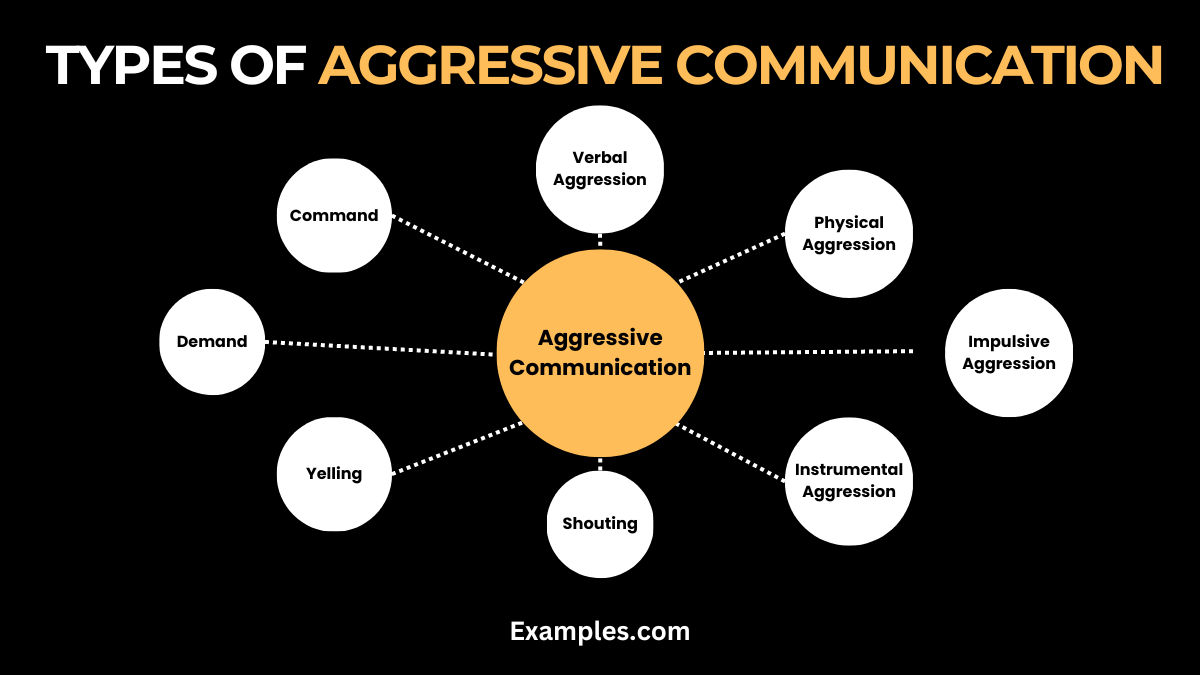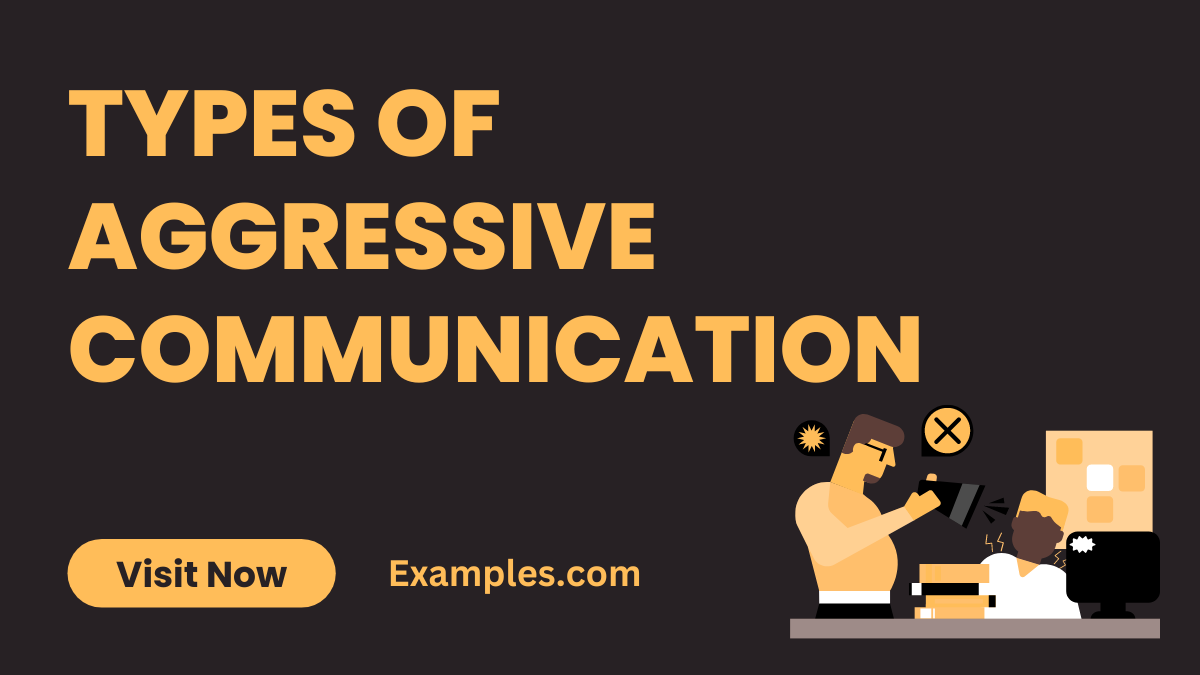10 Types of Aggressive Communication
Understanding the Types of Aggressive Communication is crucial in navigating complex interpersonal dynamics. This comprehensive guide delves into various aggressive communication styles, from verbal outbursts to subtle manipulations. It’s packed with real-life communication examples, helping readers recognize and respond effectively to different forms of aggression. Whether in the workplace, relationships, or everyday interactions, this guide offers valuable insights and strategies for dealing with aggressive communicators. Enhance your communication skills and transform potential conflicts into constructive conversations with this enlightening resource.
Types of Aggressive Communication

Verbal Aggression in Communication
Verbal aggression in communication encompasses a range of behaviors where words are used to dominate, control, or inflict harm. This guide delves into the dynamics of such aggressive communication, providing insights into its impact and management. Understanding verbal aggression is key in various settings, from personal interactions to workplace environments. Through relevant communication examples, this guide aims to illustrate the nature of verbal aggression and offer strategies for effective response and resolution.
Example: “You’re always wrong, can’t you do anything right?” This shows direct, insulting language aimed to belittle or intimidate.
Physical Aggression in Communication
Physical aggression in communication extends beyond verbal interactions, encompassing actions that are physically threatening or harmful. This guide explores different forms and contexts of physical aggression, ranging from intimidating body language to actual physical altercations. Understanding these communication examples is essential in identifying and addressing such behaviors, particularly in environments like workplaces or personal relationships where they can have significant negative impacts. It’s crucial to recognize the signs of physical aggression for effective management and prevention.
Example: Slamming a fist on the table to emphasize anger.
Impulsive Aggression in Communication
Impulsive aggression in communication is characterized by sudden, emotionally-driven responses that are often disproportionate to the situation. This guide will explore the dynamics of impulsive aggression, offering insights into its triggers and effects. It will also provide communication examples, helping readers understand how impulsive aggression manifests in interactions and its impact on relationships. The goal is to offer strategies for managing and mitigating such impulsive responses to maintain healthy communication.
Example: Sudden yelling during an argument, driven by immediate frustration.
Instrumental Aggression in Communication
Instrumental aggression in communication is a strategic form of aggressive behavior, often used to achieve specific goals or objectives. This guide will delve into how instrumental aggression manifests in various settings, its impact, and strategies for managing such communication. We will explore communication examples where instrumental aggression is employed, understanding its dynamics and consequences. The focus will be on recognizing instrumental aggression and developing effective ways to address and counteract it in both personal and professional interactions.
Example: Forcefully telling someone to complete a task to ensure your own success.
Shouting in Communication
Shouting in communication often indicates a high level of emotional intensity and can be a sign of aggression or frustration. This guide explores the nuances of shouting as a communication style, examining its causes, impacts, and the contexts in which it is used. Understanding these dynamics is crucial for managing and responding to shouting effectively in various settings. The guide also provides communication examples to illustrate how shouting can manifest and affect interactions, emphasizing the importance of maintaining professionalism and emotional intelligence in response to such challenging communication scenarios.
Example: Loudly interrupting someone to assert control.
Yelling in Communication
Yelling in communication is a potent form of verbal expression often associated with intense emotions such as anger or frustration. This comprehensive guide will explore various communication examples of yelling, examining its causes, impacts, and potential consequences in different contexts. Understanding when and why people resort to yelling can provide insights into effective communication strategies and conflict resolution. The guide aims to offer a deeper understanding of this aggressive communication form and its role in interpersonal interactions, highlighting the importance of emotional regulation and respectful dialogue.
Example: Raising voice significantly to express displeasure.
Demanding in Communication
Demanding communication, a direct and forceful style, is often used to convey urgency or authority. This guide explores various communication examples of demanding communication, highlighting its characteristics, effectiveness, and potential pitfalls. It’s crucial to balance demanding communication with respect and understanding, ensuring it does not cross into aggression or disrespect. The guide will provide insights into effectively utilizing this style in both professional and personal contexts, ensuring goals are met without compromising relationships.
Example: “I need this done now!” emphasizing urgency and command.
Commanding in Communication
Commanding in communication is a direct, authoritative style often employed in leadership or decision-making roles. This comprehensive guide will explore various communication examples of commanding style, highlighting its effectiveness and challenges. Commanding communication is characterized by clear directives, a firm tone, and often an expectation of immediate compliance. While it can be efficient in certain scenarios, balancing it with empathy and respect is crucial for maintaining positive relationships and encouraging teamwork.
Example: “Do it this way, no questions asked,” indicating no room for discussion.
Blaming in Communication
Blaming in communication is a critical aspect that negatively impacts interactions, be it in personal relationships or professional settings. This guide focuses on understanding the dynamics of blame, its effects, and how it manifests in various communication examples. Blaming often involves shifting responsibility to others, avoiding accountability, and can lead to conflict and resentment. Recognizing and addressing this pattern is essential for fostering more constructive and responsible communication practices.
Example: “This is all your fault,” shifting responsibility entirely.
Being Critical in Communication
Being critical in communication involves offering evaluative feedback, often highlighting areas for improvement. This comprehensive guide will delve into the nuances of critical communication, exploring how to deliver feedback effectively without damaging relationships. It will include communication examples that illustrate the balance between providing necessary critique and maintaining a supportive tone. The aim is to foster growth and improvement, whether in professional settings or personal interactions, through constructive and respectful critical communication.
Example: “This is inadequate, as always,” showing constant disapproval.
Being Verbally Abusive in Communication
Being Verbally Abusive in Communication involves using language in a harmful, demeaning, or hostile manner. This comprehensive guide will delve into various communication examples of verbal abuse, highlighting its characteristics and impacts. It explores how such communication can damage relationships, affect mental health, and create toxic environments. The guide aims to provide insights into identifying verbally abusive patterns and strategies for responding to or mitigating such harmful communication. Understanding these aspects is crucial for promoting healthier and more respectful interactions in all areas of life.
Example: “You’re worthless,” directly attacking someone’s self-esteem.
In concluding, the Types of Aggressive Communication guide provides essential insights into recognizing and addressing various aggressive behaviors. From verbal aggression to non-verbal cues, understanding these types equips individuals with the knowledge to navigate challenging interactions effectively. This guide serves as a valuable tool for personal growth and developing healthier communication strategies in various aspects of life, fostering more respectful and productive relationships.



